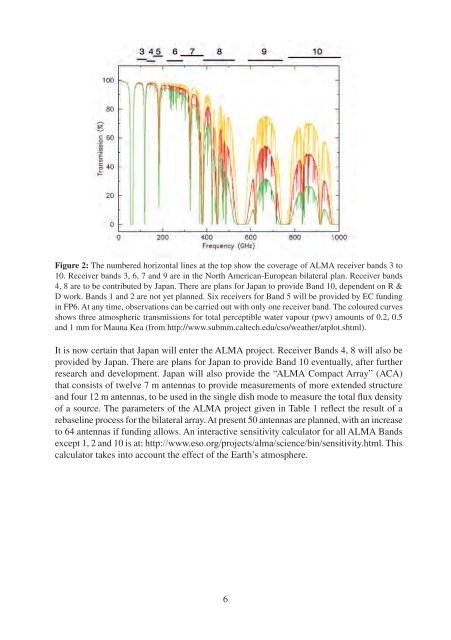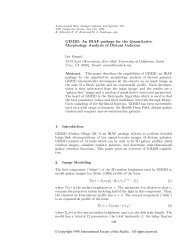4 Comparison of the ALMA and Herschel - ESO
4 Comparison of the ALMA and Herschel - ESO
4 Comparison of the ALMA and Herschel - ESO
Create successful ePaper yourself
Turn your PDF publications into a flip-book with our unique Google optimized e-Paper software.
Figure 2: The numbered horizontal lines at <strong>the</strong> top show <strong>the</strong> coverage <strong>of</strong> <strong>ALMA</strong> receiver b<strong>and</strong>s 3 to<br />
10. Receiver b<strong>and</strong>s 3, 6, 7 <strong>and</strong> 9 are in <strong>the</strong> North American-European bilateral plan. Receiver b<strong>and</strong>s<br />
4, 8 are to be contributed by Japan. There are plans for Japan to provide B<strong>and</strong> 10, dependent on R &<br />
D work. B<strong>and</strong>s 1 <strong>and</strong> 2 are not yet planned. Six receivers for B<strong>and</strong> 5 will be provided by EC funding<br />
in FP6. At any time, observations can be carried out with only one receiver b<strong>and</strong>. The coloured curves<br />
shows three atmospheric transmissions for total perceptible water vapour (pwv) amounts <strong>of</strong> 0.2, 0.5<br />
<strong>and</strong> 1 mm for Mauna Kea (from http://www.submm.caltech.edu/cso/wea<strong>the</strong>r/atplot.shtml).<br />
It is now certain that Japan will enter <strong>the</strong> <strong>ALMA</strong> project. Receiver B<strong>and</strong>s 4, 8 will also be<br />
provided by Japan. There are plans for Japan to provide B<strong>and</strong> 10 eventually, after fur<strong>the</strong>r<br />
research <strong>and</strong> development. Japan will also provide <strong>the</strong> “<strong>ALMA</strong> Compact Array” (ACA)<br />
that consists <strong>of</strong> twelve 7 m antennas to provide measurements <strong>of</strong> more extended structure<br />
<strong>and</strong> four 12 m antennas, to be used in <strong>the</strong> single dish mode to measure <strong>the</strong> total flux density<br />
<strong>of</strong> a source. The parameters <strong>of</strong> <strong>the</strong> <strong>ALMA</strong> project given in Table 1 reflect <strong>the</strong> result <strong>of</strong> a<br />
rebaseline process for <strong>the</strong> bilateral array. At present 50 antennas are planned, with an increase<br />
to 64 antennas if funding allows. An interactive sensitivity calculator for all <strong>ALMA</strong> B<strong>and</strong>s<br />
except 1, 2 <strong>and</strong> 10 is at: http://www.eso.org/projects/alma/science/bin/sensitivity.html. This<br />
calculator takes into account <strong>the</strong> effect <strong>of</strong> <strong>the</strong> Earth’s atmosphere.<br />
6




